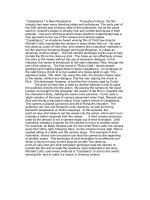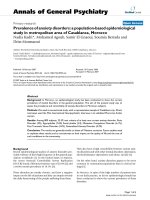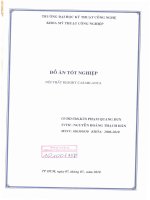casablanca
Bạn đang xem bản rút gọn của tài liệu. Xem và tải ngay bản đầy đủ của tài liệu tại đây (25.76 KB, 1 trang )
"Casablanca:" A New Perspective Throughout history, the film
industry has seen many directing styles and techniques. The early part of
the 20th century saw a factory style of film production, but as the years
went by, director's began to employ new and untried techniques in their
pictures. One such technique which these director's implemented was a
new approach to the use of the camera and camera angles.
"Casablanca," an Academy Award winning film of 1942 saw director
Michael Curtiz manipulate the camera in ways others had not. He uses
the close-up, point-of-view shot, and creative shot motivation methods in
his film starring Humphrey Bogart and Ingrid Bergman, to create an
American cinema classic. The first camera technique Curtiz uses to help
narrate the film is the close-up shot. The close-up can effectively convey
the story to the viewer without the use of excessive dialogue. In this
instance, the viewer is introduced to the main character, Rick, through the
use of the close-up. The first scene in "Rick's Cafe," shows people
gambling and making illegal deals to leave Casablanca. An employee of
the cafe bring a check to a man seated at a chess table to sign. The
signature reads, "OK. Rick." By using this shot, the director makes clear
to the reader, without any dialogue, that the man signing the check is
Rick. This technique, however, is just the first of many used by Curtiz.
The point-of-view shot is used by director Michael Curtiz to place
the audience directly into the action. By placing the camera at the exact
location and height of the character, the viewer of the film is 'inserted' into
the character's body, making the scene more personal. Curtiz uses a
slight variation of this type of camera placement when Capt. Renault and
Rick are having a discussion about Victor Laslo's arrival in Casablanca.
The camera is placed just above and aft of Renault's shoulder. The
audience can now see Renault's body reactions, as well as having
Renault's perspective on Rick's response. In this episode, the
point-of-view shot helps to set the viewer into the action, which will in turn
motivate a better response from the viewer. A third camera technique
used by the director is not a camera angle, but is shot motivation. Shot
motivation creates a purpose for the camera to move to another action.
For example, as Major Strasse and his men enter Rick's cafe, the camera
pans from left to right, following them. As the camera moves right, Rick is
spotted sitting at a table and the camera stops. This example of shot
motivation, shows how one action can lead the camera to the beginning
of another scene. This technique of shot motivation is an effective one
which is found in many current pictures as well.The close-up,
point-of-view shot and shot motivation technique help the director to
narrate the film and to keep the audience more interested in the story.
Michael Curtiz uses these methods is "Casablaca" to add to this award
winning film, and to make it a classic in America cinema.









